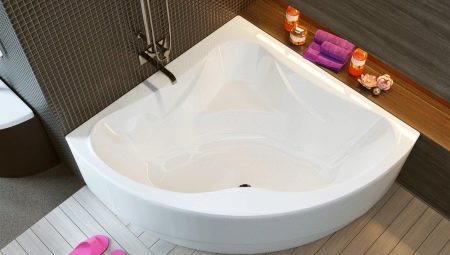Acrylic bathtubs appeared on the plumbing market relatively recently (12-15 years ago) and immediately became popular. Today, an acrylic bathtub of a standard rectangular shape will not surprise anyone. Non-standard angular models are becoming more and more popular.
Features
A corner bath is a type of asymmetric model. Its feature is the placement of such a bowl in the corner of the room, which allows more rational use of the area of the bathroom. Corner models are compact, their installation allows you to optimize the space, arrange in the bathroom all the necessary things, without cluttering up the room. As a rule, this is a sink, a washing machine and a small cabinet.
Occupying one of the corners of the room, such a bath usually has a stand for various bath accessories, which is also very ergonomic and convenient.
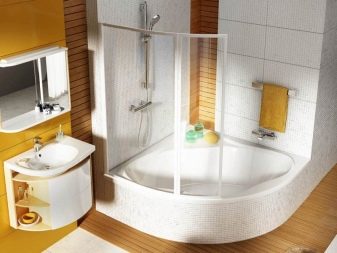
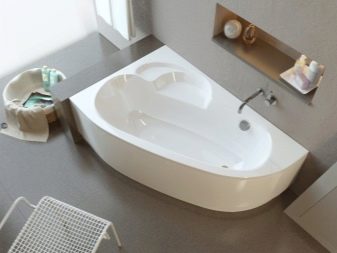
Acrylic products are the most common in the modern plumbing market, which is due to the optimal ratio of price and quality in such products. The material itself is quite lightweight, which eliminates special difficulties with the delivery and installation of the bowl.
In addition, acrylic is a fairly strong and resistant to mechanical stress material. It does not have an enamel coating, and therefore the appearance of chips and cracks on the surface of the bowl is excluded. The average service life of acrylic products is 25-30 years.
If necessary (the appearance of yellow spots, dull surface), the acrylic bathtub can be updated with a special coating.
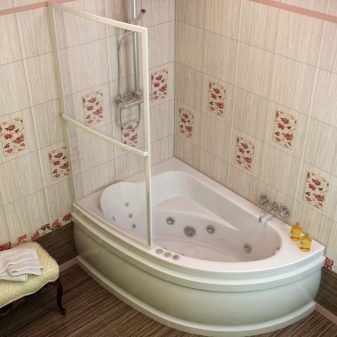
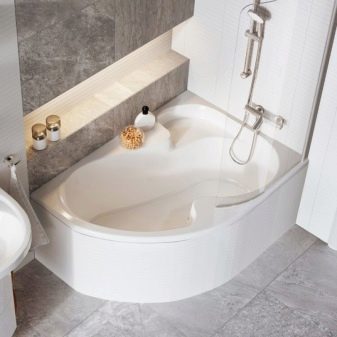
Acrylic bowls have low thermal conductivity, and therefore in such a bath the water is kept warm for a long time. The temperature drops on average by 1 degree in 1 hour.
When collecting water, such bowls do not emit strong noise (such as steel ones), do not vibrate, and do not deform.
Products look attractive, have a pleasant shine. The surface of acrylic is considered self-cleaning. It has no pores; therefore, contaminants remain on the surface and are not eaten into the material. Finally, Acrylic is a flexible and plastic option; asymmetric bathtubs of the most incredible shapes are made of it.
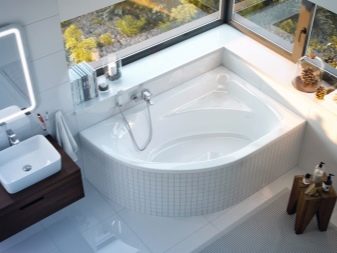

Which are there?
Depending on the features of the placement in the room, corner structures are right- and left-sided. The first are located in the corner on the right side of the bathroom, the second, respectively, on the left.
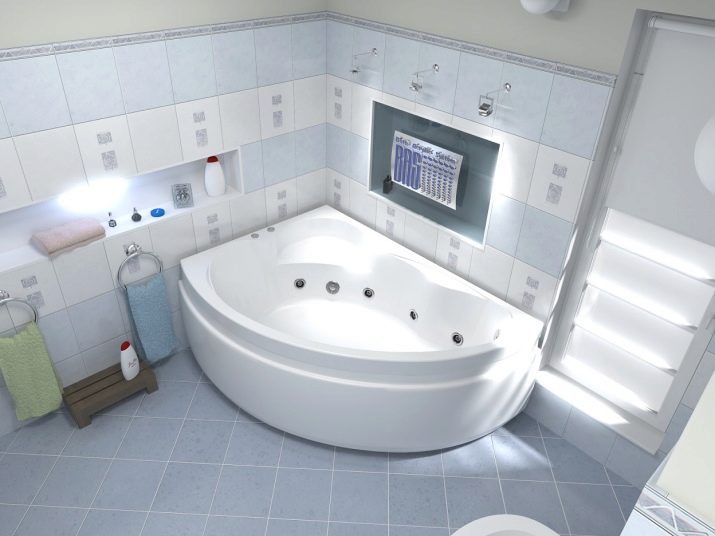
There are corner baths in the shape of the bowl itself for water collection triangular, oval, trapezoidal. The sides of the bath may form an isosceles or an irregular triangle. In the first case, we are talking about a symmetrical corner bath.
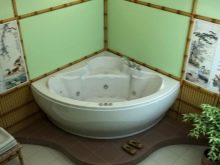
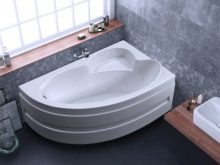
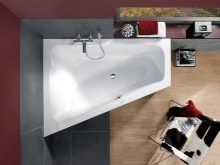
Depending on the type of acrylic used, bathtubs produced casting method and made by extrusion technology. Cast baths are more homogeneous in molecular composition, and therefore better withstand shock and damage, do not deform, are more durable.
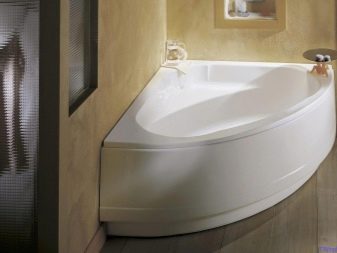
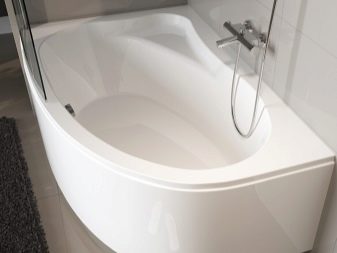
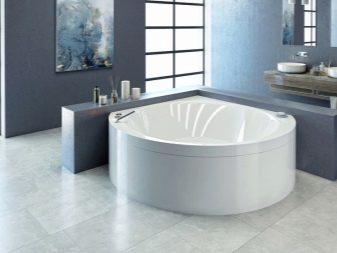
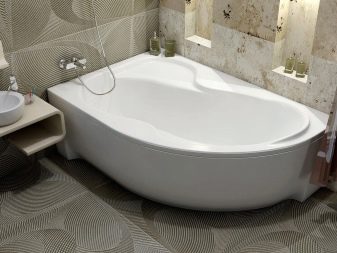
Combined acrylic bathtubs also exist., You can recognize them by marking ABS + PMMA. Such products are a specially reinforced moisture-resistant plastic, the inside of which is covered with a layer of acrylic. Despite the presence of reinforcement, such bathtubs do not withstand heavy loads, their service life is 10-12 years. Such products are often purchased for a summer residence, but also on the condition that there will not be sharp temperature drops in the house. Otherwise, the bowl may burst.
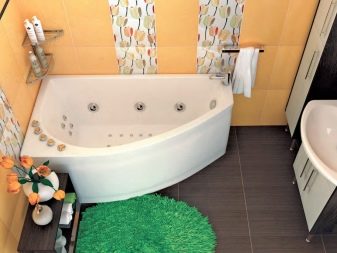

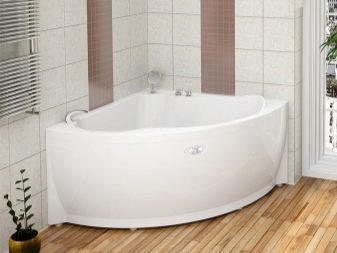
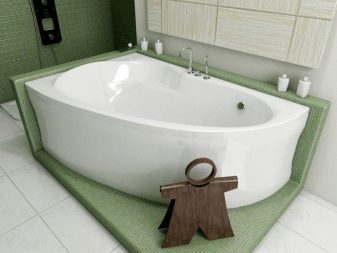
There is also one more modern material - quaril. Its development is carried out according to the patented formula of the well-known plumbing manufacturer Villeroy & Boch. Quaril is the same acrylic, in the composition of which there is an additional element - quartz sand. This provides greater strength of the product, its resistance to mechanical damage, longer life. Visually, such a bowl is no different from standard acrylic.
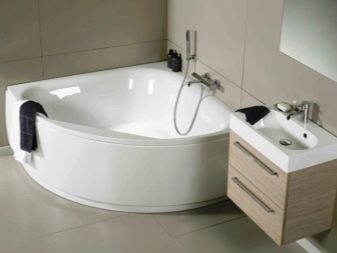
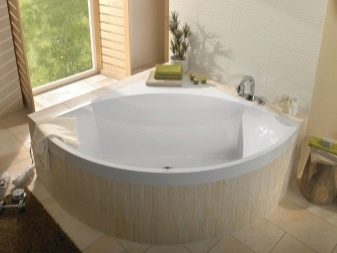
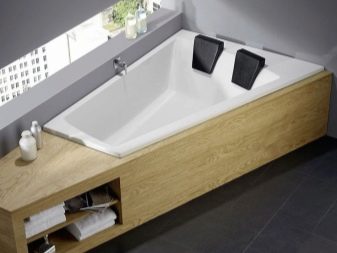
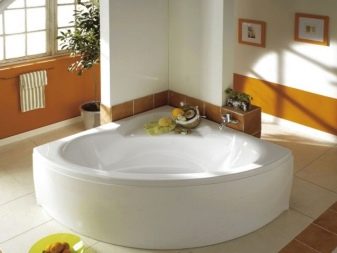
Designed such bowls can be for one or more (usually two) users. Equipped with protrusions, handles, head restraints. Depending on the availability of additional options, corner bathtubs can be equipped with a hydromassage (equipped with small siphons, from which water streams are beaten under pressure, which ensures a massage effect), an air massage (a similar device, except that the massage is performed with air bubbles), chromotherapy (multi-colored illumination of water).
More affordable models - without hydromassage and other additional features.
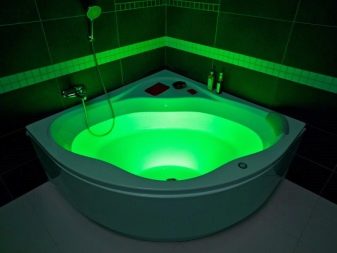
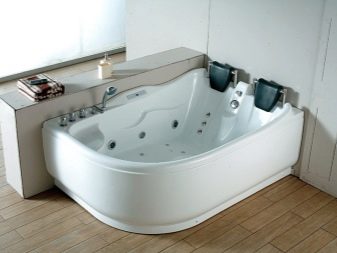
Dimensions
Acrylic corner baths can be an isosceles triangle, that is, each of the sides of the bath adjacent to the wall has the same length. Such products are called symmetrical corner bathtubs.
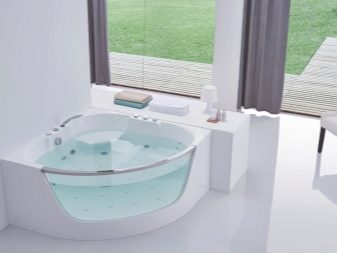
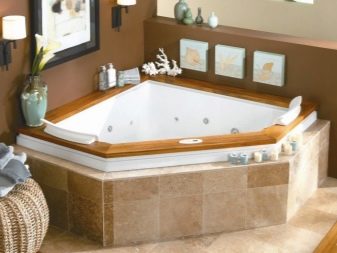
The most common are options 90x90, 100x100, 110x110, 120x120, see. Bowls with a side length of 90-100 cm are usually suitable even for small bathrooms, including rooms in Khrushchev. Larger symmetrical bathtubs - 130x130, 140x140, 150x150 cm (this model range can be found in the Ravak brand line).
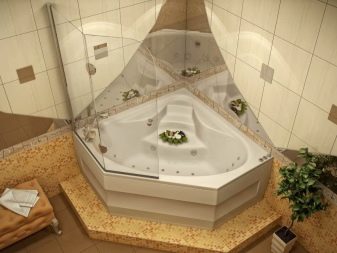
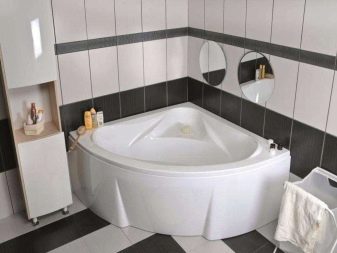
It is possible to produce symmetric angular bowls in the sizes 120x120, 135x135, 140x140, 147x147, 148x148, 156x156 cm (such a ruler is presented by Teiko). Convenient and therefore popular are considered bowls 125x125, 130x130, 135x135, 140x140, 145x145, 150x150 cm (produced by the Kolo brand).

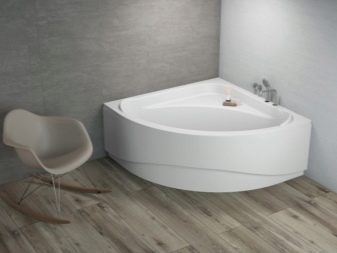
If we talk about products that have unequal lengths of sides adjacent to the wall of the bathroom, then usually one of them is 120-180 cm. This is the longest side of the product, therefore it is customary to call it length. The second side, called, respectively, the width, can be 70-165 cm.

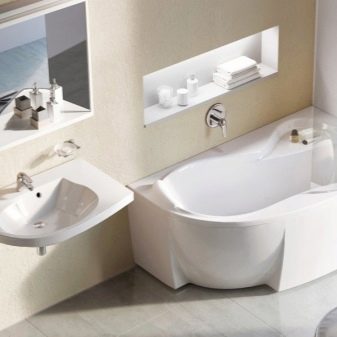
The length of the corner bowl of 120–150 cm is a small bathtub. It is designed for small rooms.It will not be very convenient for an adult of standard height in such a bath, he can only take water procedures while sitting. The advantage of such products is compactness, the ability to install even in a small bathroom, and affordability.
Among the popular small-sized options, one can distinguish bathtubs in such sizes as 120x80, 120x70, 130x70, 140x70, 140x90 and 140x100 cm.
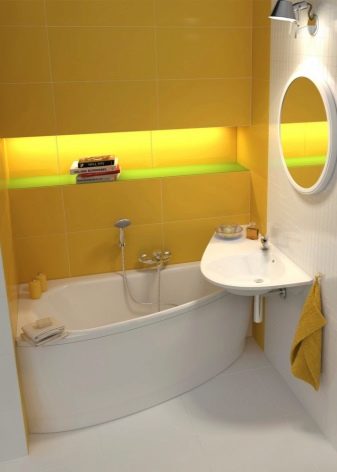
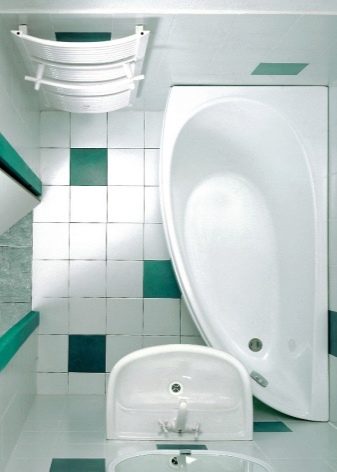
If the bath has a length of 150-170 cm, then it is considered standard (the most famous model is 150x100 cm). A bath with a length of 160-170 cm is suitable for most adults, it is possible to comfortably settle down on it.
The most popular standard models are considered to be 150x100, 160x105, 150x105, 1700x110, 150x75, 160x75 cm (size line of asymmetric corner bathtubs of the Ravak brand, it is noteworthy that the manufacturer does not produce such products with a length of less than 1500 mm).
The bath sizes are also considered standard: 180x90, 170x100, 170x90, 170x70, 160x100, 160x70, 160x90, 150x90, 150x70 cm.

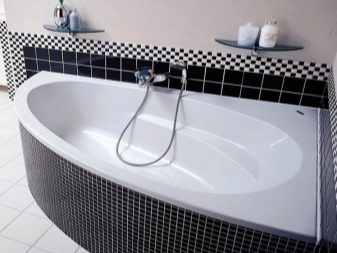
Finally, there are corner oversized bathtubs. Although they are less popular than the varieties described above. This is due to the fact that such a bath will take up too much space in the room. If it is small, then installing such a bowl loses all meaning (it will clutter up the bathroom). If we are talking about placing a large area, then instead of a large angular option, many prefer a trapezoid or stand-alone round or oval font.
The length of the large corner bowl is from 170 to 200 mm.
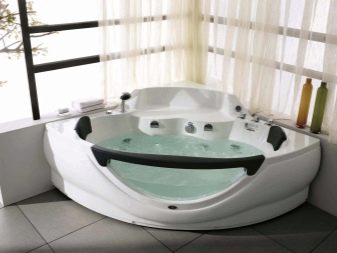
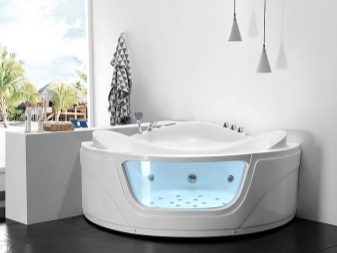
Speaking about the size of the bath, one should mention such a parameter as the depth of the bowl. It varies between 42-50 cm, as a rule, many European baths have a shallow depth - from 37 to 45 cm. Most of the domestic options are bowls with a depth of 47-50 cm. should be at least 45–47 cm. However, if the product is used by older people, preference should be given to less deep products.
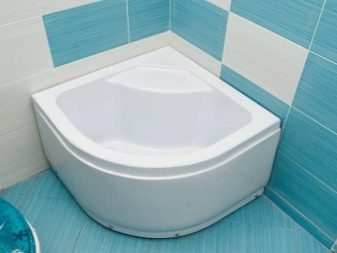
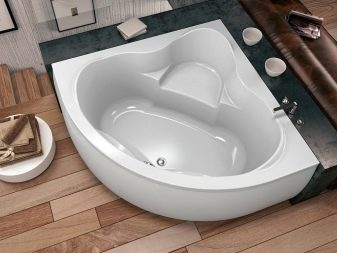
Selection rules
First of all, you should decide on the size of the bowl before buying. They are selected based on the size of the bathroom. The second important point to consider is which wall (right or left) the bath will be located on. Depending on this, a left-side or right-side bowl is selected.
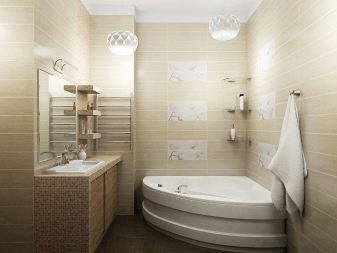
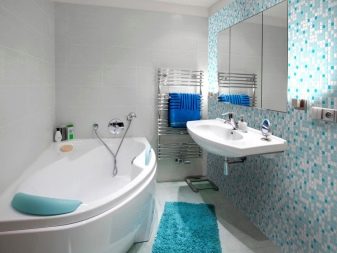
Then you need to pay attention to the thickness of the walls of the bath. It should be 5-8 mm. The optimum in relation to the balance “price - quality” is a thickness of 5-6 mm. If the bath volume is large or if a dimensional person will use it, then you should strive to choose a bowl with the thickest walls.
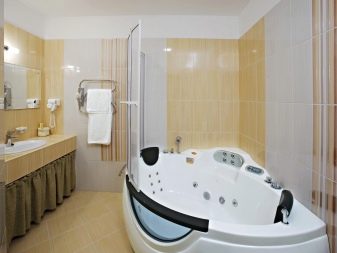
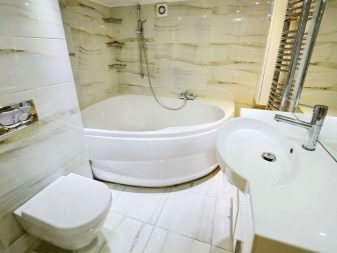
Another buying criterion is the number of reinforcing layers. There should be at least 3, ideally 5. If such layers are insufficient, the bowl may become deformed. You can determine the number of layers by looking at the edge of the sides. Just as the tree rings are noticeable on a tree saw, the number of reinforcing layers can be calculated along the very edge of the bath.
You can additionally illuminate the walls of the bath with a regular pocket flashlight. If you attach the turned-on flashlight to the outer wall of the bathtub, you see how light appears from the inside (or vice versa), this indicates the subtlety of the walls of the bowl. You should refuse to purchase such a product.
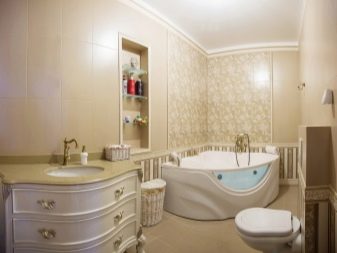
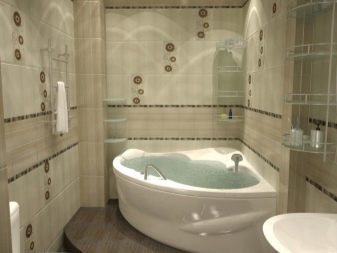
Swipe the inside of the bowl with your hand - there should be no bumps, bumps, rough areas. The same applies to shade with brilliance - the presence of white and gray spots, dark spots is unacceptable. The color on the entire surface should be uniform.

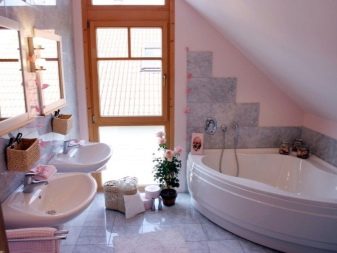
Take a look at the product - the smell should be neutral. The presence of any chemical "amber" indicates a low quality product. Tap the walls of the bathtub, a dull sound should be heard.
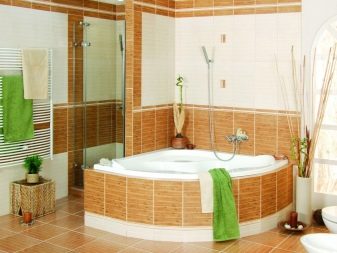
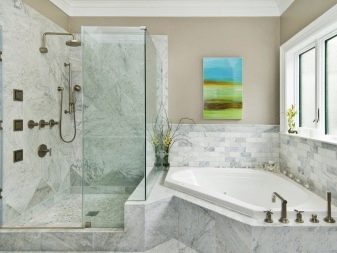
Pay attention to the shape of the bowl. Ideally, in that part of the font where the head of the bathing person will be located, there will be a special protrusion of an anatomical shape or a rubberized headrest.
This will ensure safety and maximum relaxation while taking a bath.
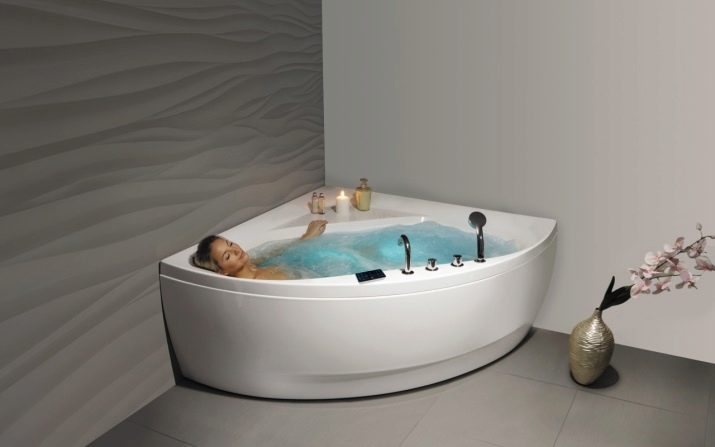
Manufacturers
Manufacturers of the best plumbing are companies from Italy and Germany. It is worth noting that considerable amounts have to be paid for the corresponding quality and durability. You need to purchase expensive branded products in specialized stores and first make sure that you have an original product in front of you. It is the famous Italian, German and Czech baths that are faked most often.

The most durable and popular corner bathtubs in Russia are produced by the company Ravak. The most affordable are the bowls of the Polish brand Cersanit, however, they have a significant minus - too thin walls of the bowl. The most environmentally friendly product belongs to a German company Kaldewei.
According to the manufacturer, the product can be recycled without any waste.
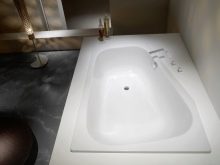
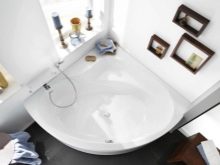
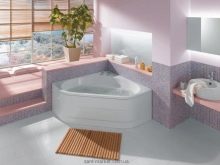
Let's take a closer look at the most popular manufacturers of acrylic corner bathtubs.
- Ravak. The Czech brand, which is popular not only in Russia but also in Europe. It is due to the high quality of products (walls with a thickness of 6 mm, the use of cast acrylic only). Corner models are represented by both symmetric and asymmetric bowls, many bathtubs with air massage, hydromassage, and backlight.
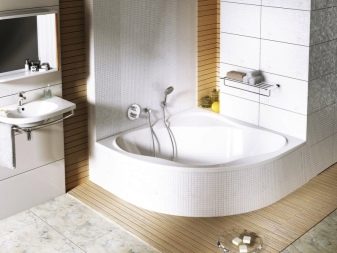

- Roca. The products of this Italian brand are considered elite, characterized by high quality and stylish design. The corner models with large transparent inserts are especially impressive - such a bathtub looks stylish, resembles a pool, visually expands the bathroom.
When choosing, preference should be given to products made in Italy. The fact is that the company has production facilities in Russia, however, products made there often have defects.
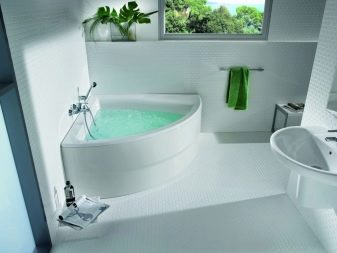
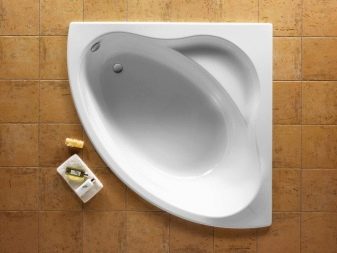
- Cersanit. A brand loved by many buyers for affordability. However, bathtubs have thin walls, so people with a lot of weight should definitely refuse to buy. It is recommended to purchase bathtubs produced by Polish plants. Since those that are produced by domestic and Ukrainian (under the brand name Cersanit) also often have a marriage.
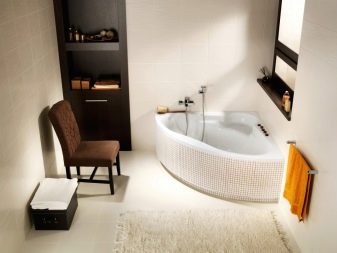
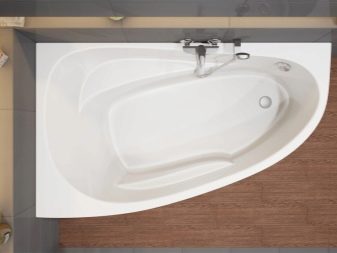
- Riho. A brand producing symmetrical (145 by 145, 150 by 150) and asymmetric (160 by 70, 160 by 90) corner baths with 8 mm thick walls, a double reinforced bottom and an antibacterial surface coating. The only drawback is the strong run-up of prices between standard-shaped products and corner models. The latter are much more expensive.
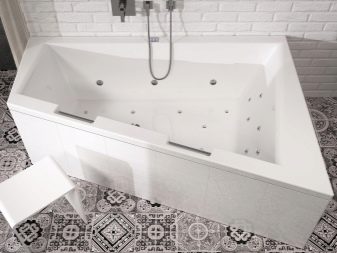
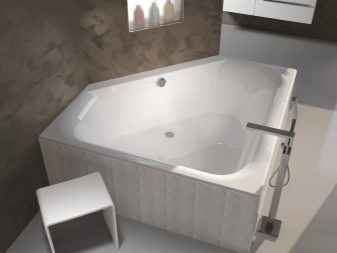
Examples in the interior
An example of a compact arrangement of a corner bowl in a small bathroom. Pay attention to the outer part of the bathtub - it is rounded, which gives the entire interior softness, a classic sound.
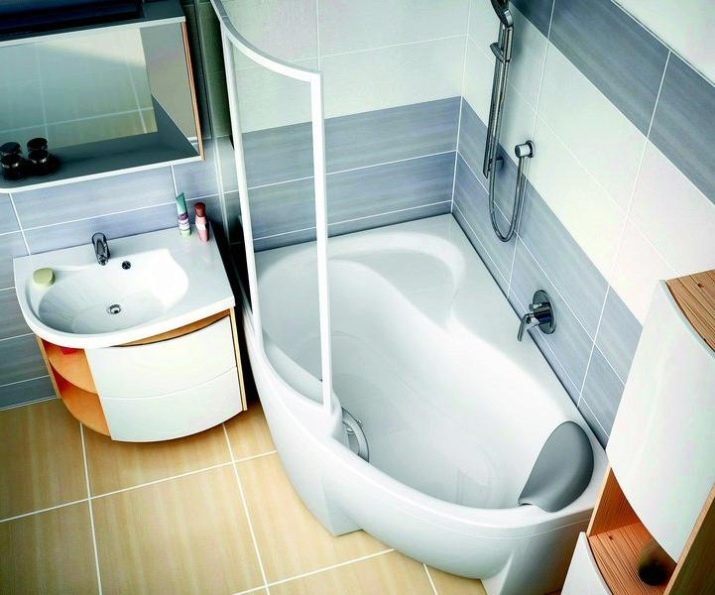
Another option for mounting an asymmetric corner bath in a small room. The sink slightly hangs over the bowl, which does not interfere with water procedures, because in this part the legs of the person resting in the bath are located. The bowl itself has a convenient teardrop shape. The space above the drain is very well used - a part of the sink rises above it, which is a shelf for cosmetics.
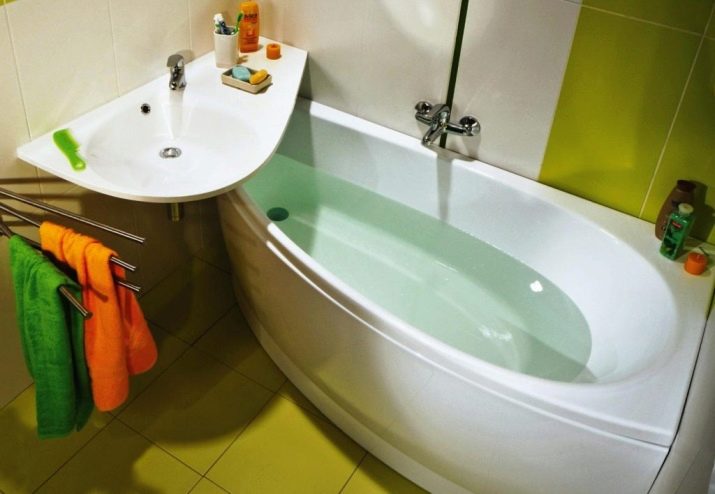
Convenient and cozy space, which is more correctly called a SPA corner. Such a symmetrical angular model fits equally well in a small bathroom and a more spacious room. The space above the sinks is a niche in which it is convenient to store bath accessories.
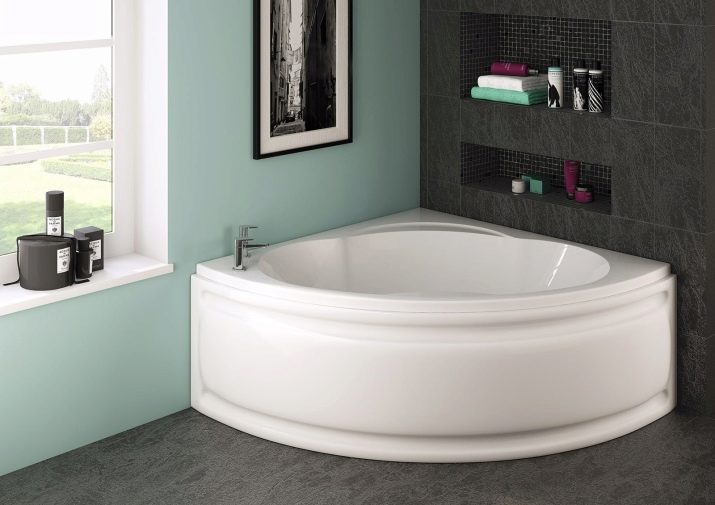
Combined bathroom option using an asymmetric corner bath. A similar arrangement (bath and toilet on one side) is standard. Visually expand the room allows the use of a classic white shade of plumbing. And to avoid monotony - interspersing a pleasant green tint.
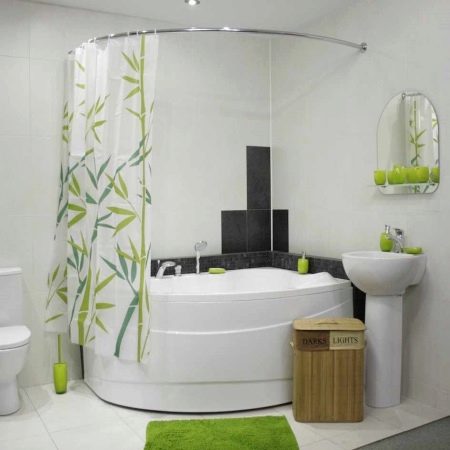
See the following video for the advantages and disadvantages of acrylic bathtubs.
